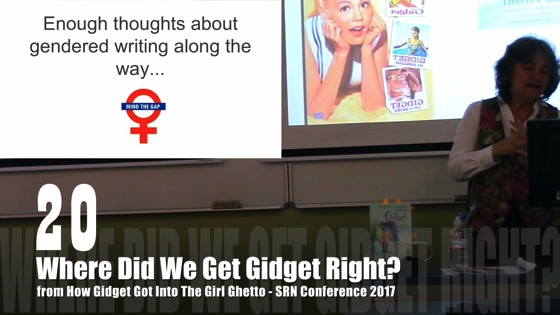20 Where Did We Get Gidget Right? from How Gidget Got Into the Girl Ghetto with Dr. Rosanne Welch
Watch this entire presentation
Transcript:
So, I really wanted to wrap up with the idea, so where did we get the Gidget book right? Was it in the movies or in the TV show? I’m going to guess, just because I’m pushy and that’s what I pushed on you, it is, in fact, the TV show and I’m going to say that’s because TV is where meat-and-potatoes stories can be told. We have a hundred or 200 hours to tell you the story of one character. They can’t be weak and superficial or you won’t come back. We need to really get into their hearts and hear about them and that’s the beauty of television as opposed to bubblegum in films and also TV has often been — and I’m not saying Gidget is part of the golden age of television — but when we discuss the Golden Age of Television we discuss it like Dickensian novels, that every month, every week, you get another section of the story and that’s the power of television. We can expand on a character because you’ve come to love them and you’ll watch them go through two or three or seven years of their lives and that’s much more in-depth than you can get into a film which is where Gidget falls apart if you ask me.
At this year’s 10th Annual Screenwriting Research Network Conference at Otago University in Dunedin, New Zealand I presented…
“How Gidget Got Into the Girl Ghetto by Accident (and How We Can Get Her Out of it): Demoting Gidget: The Little Girl with Big Ideas from Edgy Coming of Age Novel to Babe on the Beach Genre Film via Choices made in the Adaptation Process.”
It’ a long title, as I joke up front, but covers the process of adapting the true life story of Kathy Kohner (nicknamed ‘Gidget’ by the group of male surfers who she spent the summers with in Malibu in the 1950s) into the film and television series that are better remembered than the novel. The novel had been well-received upon publication, even compared to A Catcher in the Rye, but has mistakenly been relegated to the ‘girl ghetto’ of films. Some of the adaptations turned the focus away from the coming of age story of a young woman who gained respect for her talent at a male craft – surfing – and instead turned the focus far too much on Kathy being boy crazy.
Along the way I found interesting comparisons between how female writers treated the main character while adapting the novel and how male writers treated the character.
Dr. Rosanne Welch
Dr. Rosanne Welch teaches the History of Screenwriting and One-Hour Drama for the Stephens College MFA in Screenwriting.
Writing/producing credits include Beverly Hills 90210, Picket Fences, ABCNEWS: Nightline and Touched by an Angel. In 2016 she published the book Why The Monkees Matter: Teenagers, Television and American Pop; co-edited Women in American History: A Social, Political, and Cultural Encyclopedia; and placed “Transmitting Culture Transnationally Via the Characterization of Parents in Police Procedurals” in the New Review of Film and Television Studies. Essays appear in Torchwood Declassified: Investigating Mainstream Cult Television and Doctor Who and Race: An Anthology. Welch serves as Book Reviews editor for Journal of Screenwriting and on the Editorial Advisory Board for Written By magazine, the magazine of the Writers Guild.
Watch Dr. Welch’s talk “The Importance of Having a Female Voice in the Room” at the 2016 TEDxCPP.
The Screenwriting Research Network is a research group consisting of scholars, reflective practitioners and practice-based researchers interested in research on screenwriting. The aim is to rethink the screenplay in relation to its histories, theories, values and creative practices.
Podcast: Play in new window | Download
Subscribe: RSS


